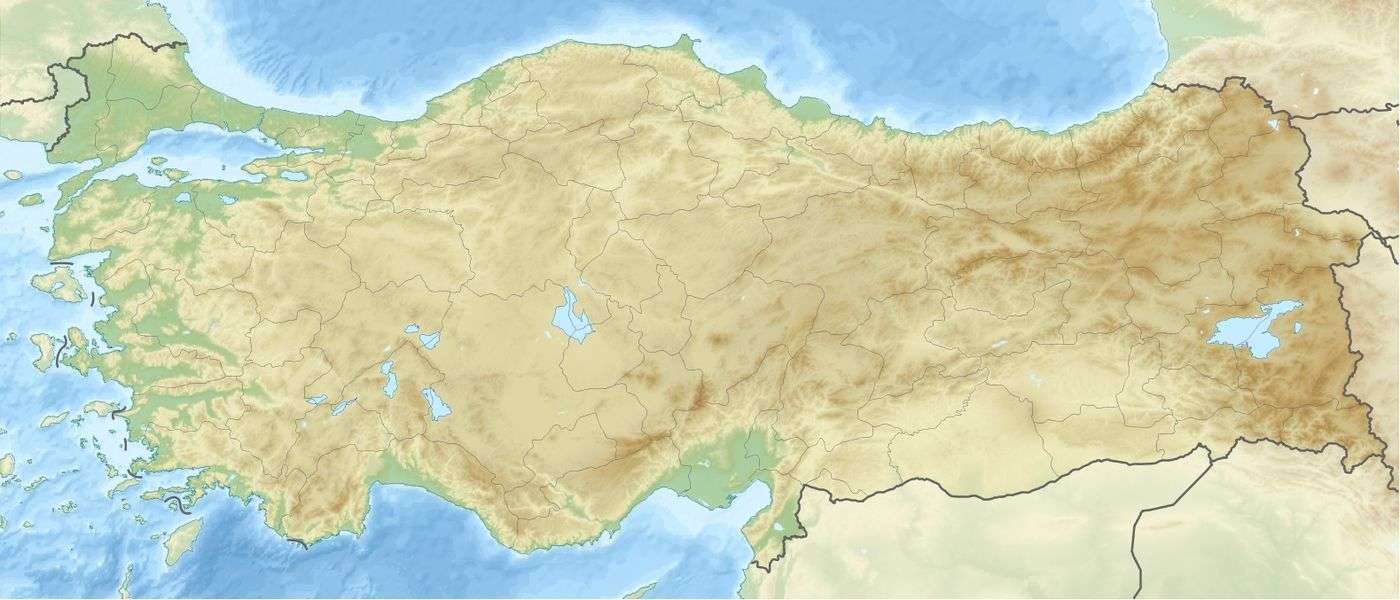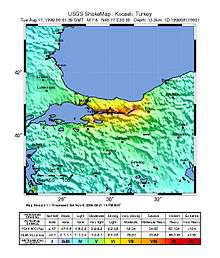1999 İzmit earthquake
 Istanbul Ankara | |
| Date | 17 August 1999 |
|---|---|
| Origin time | 00:01:40 UTC[1] |
| Duration | 37 seconds[2] |
| Magnitude | 7.6 Mw[1][3] |
| Depth | 15 km (9.3 mi)[1] |
| Epicenter | 40°49′N 29°59′E / 40.81°N 29.98°ECoordinates: 40°49′N 29°59′E / 40.81°N 29.98°E[1] |
| Type | Strike-slip[2] |
| Areas affected | Turkey |
| Total damage | 3–8.5 billion USD[3] |
| Max. intensity | IX (Violent) [4] |
| Peak acceleration | .3–.4g[2] |
| Tsunami | 2.52 m (8 ft 3 in)[3] |
| Casualties |
17,118–17,127 dead[3] 43,953–50,000 injured[3] |
The 1999 İzmit earthquake (also known as the Kocaeli, Gölcük, or Marmara earthquake) occurred on 17 August at 03:01:40 local time in northwestern Turkey. The shock had a moment magnitude of 7.6 and a maximum Mercalli intensity of IX (Violent). The event lasted for 37 seconds, killing around 17,000 people[5] and left approximately half a million people homeless. The nearby city of İzmit was very badly damaged.
Earthquake
The earthquake occurred along the western portion of the North Anatolian Fault Zone (NAFZ). The Anatolian Plate, which consists primarily of Turkey, is being pushed west about 2–2.5 cm (0.8–1.0 in) a year, as it is squeezed between the Eurasian Plate to the north and the Arabian Plate to the south.[6] Major earthquakes in Turkey result mainly from slip along the NAFZ or the East Anatolian Fault.
The Izmit earthquake had a rupture length of 150 kilometers (93 mi) extending from the city of Düzce all the way into the Sea of Marmara along the Gulf of İzmit. Offsets along the rupture were as large as 5.7 meters (18.7 ft).[7]
Damage
Destruction in Istanbul was concentrated in the Avcılar district to the west of the city. Avcılar was built on relatively weak ground mainly composed of poorly consolidated Cenozoic sedimentary rocks, which makes this district vulnerable to any earthquake.[8]

The earthquake was heavily felt in this industrialized and densely populated urban area of the country, including oil refineries, several automotive plants, and the Turkish navy headquarters and arsenal in Gölcük, increasing the severity of the loss of life and property. The earthquake also caused considerable damage in Istanbul, about 70 kilometres (43 mi) away from the earthquake's epicenter.[2]
An official Turkish estimate of October 19, 1999, placed the toll at 17,127 killed and 43,959 injured, but many sources suggest the actual figure may have been closer to 45,000 dead and a similar number injured.[5] Reports from September 1999 show that 120,000 poorly engineered houses were damaged beyond repair, 30,000 houses were heavily damaged, 2,000 other buildings collapsed and 4,000 other buildings were heavily damaged. 300,000 people were left homeless after the earthquake.
There was extensive damage to several bridges and other structures on the Trans-European Motorway (European route E80), including 20 viaducts, 5 tunnels, and some overpasses. Damage ranged from spalling concrete to total deck collapse.[9]
Fire
The earthquake sparked a disastrous fire at the Tüpraş petroleum refinery. The fire began at a state-owned tank farm and was initiated by naphtha that had sloshed out of a holding tank. Breakage in water pipelines, results of the quake, nullified attempts at extinguishing the fire. Aircraft were called in to douse the flames with foam. The fire spread over the next few days, warranting the evacuation of the area within three miles of the refinery. The fire was declared under control five days later after claiming at least seventeen tanks and untold amounts of complex piping.[10]
Tsunami
The earthquake caused a tsunami in the Sea of Marmara that was about 2.5 meters high. The tsunami caused the deaths of 155 people.[11]
Response
A massive international response was mounted to assist in digging for survivors and assisting the wounded and homeless. Rescue teams were dispatched within 24–48 hours of the disaster, and the assistance to the survivors was channeled through NGOs and the Red Crescent and local search and rescue organizations.

The following table shows the breakdown of rescue teams by country in the affected locations:
| Location | Foreign Search and Rescue Teams From: |
|---|---|
| Gölcük, Kocaeli | Hungary, Israel, France, South Korea, Belgium, Russia |
| Yalova | Germany, Hungary, Israel, Poland,[12] United Kingdom, France, Austria, Romania, South Korea |
| Avcılar, Istanbul | Germany, Greece |
| İzmit, Kocaeli | Russia, Hungary, France, Germany, Austria, Switzerland, United States, Iceland, South Korea |
| Sakarya | Bulgaria, Germany, Spain, Egypt |
| Düzce | Poland,[12] United Kingdom |
| Bayrampasa, Istanbul | Italy |
| Kartal, Istanbul | Azerbaijan |
Search and Rescue Effort as of August 19, 1999. Source: USAID[13]
In total, rescue teams from twelve countries assisted in the rescue effort.
Oil Spill Response Limited were activated by BP to deploy from the United Kingdom to the Tupras Refinery where their responders successfully contained the previously uncontrolled discharge of oil from the site into the sea.[14]
The U.K announced an immediate grant of £50,000 to help the Turkish Red Crescent, while the International Red Cross and Red Crescent pledged £4.5 million to help victims. Blankets, medical supplies and food were flown from Stansted airport. Engineers from Thames Water went to help restore water supplies. India also assisted by providing 32,000 tents and 2 million rupees to help in the reconstruction process.
US President Bill Clinton[15] and Pakistani Prime Minister Nawaz Sharif later visited Istanbul and İzmit to examine the level of destruction and meet with the survivors.
See also
References
- 1 2 3 4 ISC (2014), ISC-GEM Global Instrumental Earthquake Catalogue (1900–2009), Version 1.05, International Seismological Centre
- 1 2 3 4 Barka, A. (1999), "The 17 August 1999 Izmit Earthquake", Science, American Association for the Advancement of Science, 285 (5435): 1858–1859, doi:10.1126/science.285.5435.1858
- 1 2 3 4 5 USGS (September 4, 2009), PAGER-CAT Earthquake Catalog, Version 2008_06.1, United States Geological Survey
- ↑ USGS (December 1, 2008), EXPO-CAT Earthquake Catalog, Version 2007-12, United States Geological Survey
- 1 2 Marza, Vasile I. (2004). "On the death toll of the 1999 Izmit (Turkey) major earthquake" (PDF). ESC General Assembly Papers, Potsdam: European Seismological Commission. Archived (PDF) from the original on 9 April 2008. Retrieved 5 March 2008.
- ↑ USGS (June 18, 2012). "Tectonic summary". Historic Earthquakes Magnitude 7.6 TURKEY 1999 August 17 00:01:39 UTC. Retrieved 2 February 2013.
- ↑ Reilinger, R.E.; Ergintav S.; Bürgmann R.; McClusky S.; Lenk O.; Barka A.; Gurkan O.; Hearn L.; Feigl K.L.; Cakmak R.; Aktug B.; Ozener H. & Töksoz M.N. (2000). "Coseismic and Postseismic Fault Slip for the 17 August 1999, M = 7.5, Izmit, Turkey Earthquake" (PDF). Science. American Association for the Advancement of Science. 289: 1519–1524. doi:10.1126/science.289.5484.1519.
- ↑ Ergin, M.; Özalaybey S.; Aktar A. & Yalçin M.N. (2004). "Site amplification at Avcılar, Istanbul" (PDF). Tectonophysics. Elsevier. 391. doi:10.1016/j.tecto.2004.07.021.
- ↑ Lusas software, "Seismic Assessment of the Mustafa Inan Viaduct"
- ↑ Scawthorn; Eidinger; Schiff, eds. (2005). Fire Following Earthquake. Reston, VA: ASCE, NFPA. ISBN 9780784407394.
- ↑ National Geophysical Data Center. "Tsunami event". Retrieved 2 February 2013.
- 1 2 http://www.psp-nowysacz.pl/content.php?body=page&name=historia5
- ↑ Tang, Alex K., ed. (2000). Izmit (Kocaeli), Turkey, earthquake of August 17, 1999 including Duzce Earthquake of November 12, 1999 Lifeline Performance. American Society of Civil Engineers. p. 259. ISBN 978-0-7844-0494-2.
- ↑ Girgin S. (2011). "The natech events during the 17 August 1999 Kocaeli earthquake: aftermath and lessons learned" (PDF). Natural Hazards and Earth System Sciences. 11: 1129–1140. doi:10.5194/nhess-11-1129-2011.
- ↑ Bill Clinton visits İzmit,Turkey
External links
| Wikimedia Commons has media related to 1999 Izmit earthquake. |
- M7.6 - western Turkey – United States Geological Survey
- 17 August 1999 Kocaeli Earthquake – The European Association for Earthquake Engineering
- Initial Geotechnical Observations of the August 17, 1999, Izmit Earthquake – National Information Service for Earthquake Engineering